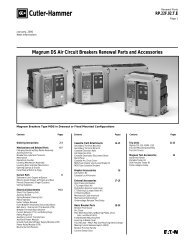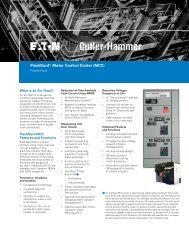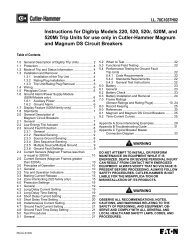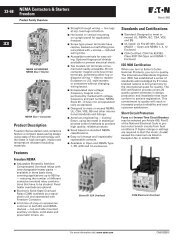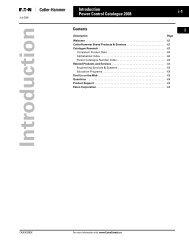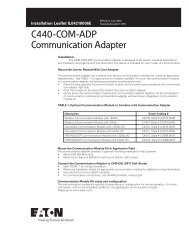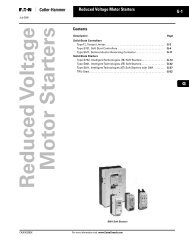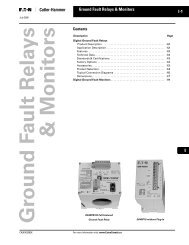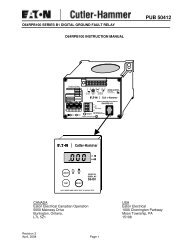molded case circuit breakers - Eaton Canada
molded case circuit breakers - Eaton Canada
molded case circuit breakers - Eaton Canada
Create successful ePaper yourself
Turn your PDF publications into a flip-book with our unique Google optimized e-Paper software.
182<br />
Selection Guide — Brush Type Control<br />
Catalog<br />
Number<br />
14-100<br />
Field application<br />
panel only<br />
14-200, 14-203,<br />
14-204, 14-206,<br />
14-600, 14-603,<br />
14-604, 14-606<br />
Complete<br />
synchronous<br />
low-voltage starter<br />
S/V F02,<br />
S/V R02,<br />
S/V A02<br />
Complete<br />
synchronous<br />
AMPGARD<br />
medium-voltage<br />
starter<br />
SYNCHRONOUS MOTOR CONTROL<br />
Selection Guide for Brush Type Motors<br />
GENERAL INFORMATION<br />
Brush Type Synchronous Motor<br />
Brush type (slip ring) motors have<br />
stators similar to squirrel-cage induction<br />
motors and most have rotors with DC slipring<br />
<strong>circuit</strong>s which must be energized for<br />
normal operation. They have two basic<br />
switching functions. The first is the energizing<br />
of the stator to produce breakaway<br />
torque and acceleration to synchronizing<br />
speed. The second is the energizing of the<br />
DC rotor field at optimum speed and rotor<br />
stator pole relationship.<br />
Primary<br />
3-Phase<br />
Voltage<br />
208-600<br />
2300-7200<br />
2300-15000<br />
208-600<br />
2300-7200<br />
2300-15000<br />
208-600<br />
2300-7200<br />
Relay Type<br />
with or without<br />
Static Exciter —<br />
Maximum Field<br />
Amperes 400<br />
<br />
<br />
<br />
➊ Contact your local Cutler-Hammer Field Sales Office.<br />
➊<br />
➊<br />
Motor Field Excitation – Brush Type<br />
For brush type motors, DC power for the<br />
field <strong>circuit</strong> is required. This DC power<br />
may be obtained from plant buses, direct<br />
drive DC generators or individual MG sets.<br />
An alternative to the above is a factory<br />
installed static power exciter which may<br />
be supplied with the field application panel.<br />
This unit may be a “constant potential”<br />
exciter with silicon diodes and transformer<br />
with adjustable taps or an “adjustable<br />
potential” exciter with SCRs which has<br />
its voltage output adjustable via a door<br />
mounted potentiometer.<br />
Solid-State<br />
Type —<br />
Mark V<br />
with Static Exciter<br />
—<br />
Max. Field<br />
Amperes 400<br />
<br />
<br />
<br />
<br />
<br />
Page<br />
Number<br />
this<br />
Publication<br />
or Price<br />
List<br />
184-185<br />
184-185<br />
184-185<br />
186-187<br />
186-187<br />
186-187<br />
188-189<br />
PL 8810<br />
Ratings:<br />
Low Voltage – 600V max.<br />
Medium Voltage – 7200V max.<br />
High Voltage – 15,000V max. (Service)<br />
Chronology:<br />
Synchronous control was introduced<br />
in 1947 at Buffalo General Control. The<br />
product moved with General Control to<br />
Asheville, NC in 1978 where it is currently<br />
manufactured.<br />
Synchronous Motor<br />
Control Instructions<br />
IL 17097<br />
IL 17097<br />
IL 17097<br />
IL 17224<br />
IL 17224<br />
IL 17224<br />
IL 17097<br />
IL 17224<br />
IL 17097<br />
IL 17224<br />
IB 48008<br />
IB 48009<br />
Comments<br />
Primary control<br />
existing or supplied<br />
by others. Primary<br />
control may be<br />
low-voltage motor<br />
starter, Full Voltage<br />
(FV) or Reduced<br />
Voltage (RV) or<br />
medium-voltage<br />
motor starter, FV or<br />
RV or <strong>circuit</strong> breaker<br />
motor control<br />
Primary control<br />
consists of<br />
low-voltage FV or<br />
RV motor starter —<br />
combination<br />
or non-combination<br />
type<br />
Primary control<br />
consists of an<br />
AMPGARD type<br />
medium-voltage,<br />
FV motor starter —<br />
full-voltage or<br />
reduced voltage<br />
type<br />
March 2001




